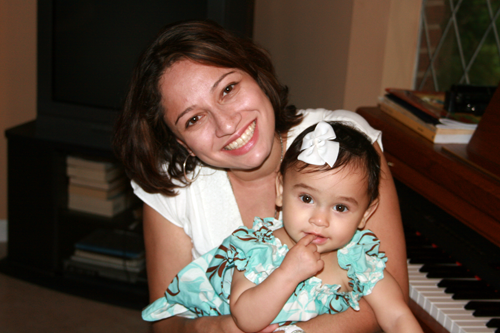“Mommy can’t play with you anymore,” my husband told my one-year-old daughter.
In 2010, I was half alive and lying on the couch. Though the words hurt to hear, they were true. I was exhausted and in pain. I’d get dizzy just from being exposed to the sun walking to my car. I couldn’t play outside with my daughter, I could barely move my legs some days, and my mind was always in a fog. My body and face, swollen and so weak that I broke bones easily, resembled very little of the person I had been several years before.
I’d been diagnosed with Sjögren’s Syndrome, an autoimmune disease that, though little-known and considered a “minor” condition, felt to me like a death sentence. The main symptom of the disease is a lack of moisture in the body, including severe dryness in the mouth and sinuses. But it can also cause digestive issues, arthritis, sun sensitivity, and fatigue.

One day, after weeks of staying in the same clothes, sinking deeper into depression, and feeling ill from the disease, my husband gave me an ultimatum: Find a way to return to the woman I once was when he married me, or else.
I enrolled in the most exhaustive form of therapy I had ever encountered: Dialectical Behavioral Therapy. DBT, invented by psychologist Marsha Linehan (who herself had schizophrenia), is an aggressive rechanneling of the thought process through intense study of the way we think and behave. Mainly developed to treat people with Borderline Personality Disorder, students learn how to replace hurtful behaviors with mindfulness techniques, looking at life with a more complex viewpoint.
Here’s an example: I felt tremendous anxiety over every symptom from my disease and believed I was dying. In my DBT studies, I learned to identify triggers for anxiety (extra stress, feeling sick, out-of-routine schedule) and to plan ahead to deal with the stress when it arrived. Instead of reacting to my stress, I learned to accept it and allowed it to play out. (This is known as using Distress Tolerance.) I did not make decisions in the midst of anxiety. I like the technique of distraction during a stressful moment, such as knitting, walking, or working on a engrossing activity.
I learned to self-soothe with the senses in the middle of extreme emotions and to accept undesirable situations. I analyzed my self-talk (“I’m a useless mother/wife/person”) and looked at its validity by writing extensive notes on my past successes, my best qualities. This technique is referred to as Emotional Regulation.
The practice of Wise Mind taught me to delay judgment against myself and others, instead looking mindfully at my own or others’ actions and thoughts. Lastly, one of the most helpful techniques I used was being able to live in the present, to appreciate and ground myself in everyday pleasures and to base decisions on the here and now. Putting my daughter to bed was suddenly enriched by the smell of her hair, the curve of her bottom lip, the shift of her chest as she fell asleep.
Another DBT technique that was useful to me was Opposite Action. In times of extreme stress, do the opposite of what you feel like doing. By focusing on an activity such as exercising or cleaning the house, you might start to actually enjoy and want to do it; other times, the stress is diminished through your determination to just get the activity done.
I started to discover maybe I wasn’t imminently dying, but instead suffering a great deal. I did the hardest thing that I had ever done in my life: I accepted it. I accepted that I was physically hurting. I accepted the behaviors and failures of my past and hurtful relationships. And I found a way to look at the present, to live mindfully, and discover what things I could change.
Research shows that DBT makes changes in the brain. According to a 2007 study by K. Schnell and S. C. Herpertz published in the Journal of Psychiatric Research, patients with Borderline Personality Disorder responded less to negative stimuli by measurements of brain blood flow and activity. The study also reported neural changes in patients in the limbic and cortical regions of the brain, areas that control emotion, motivation, and behavior after 12 weeks of DBT therapy.
Usually, patients who study DBT enroll in months of group classes and individual therapy. Attendance is often mandatory, and there is homework assigned. Every week, therapists encourage participation to ensure progress. The therapist must approve the patient’s discharge from the program, and may allow the patient to continue a less frequent after-care program to maintain skills. Believe me, it’s worth it.
I had struggled with depression my whole life, and Cognitive Behavioral Therapy had never successfully changed my destructive way of thinking, the self-doubts (“I can’t do anything”) and illogical fears (“If I put my head under the water, I will immediately die”).
But through DBT I am convinced I literally created new neurological pathways in my brain, through repetitive practice and action. I carried around a little index card notebook with all my techniques, and even when it felt counterintuitive and against my most ingrained habits, I practiced these modes of living anyway.
Today, I feel more energetic and spirited than I did even before the illness. I will never completely overcome the disease and the depression, but mindfulness therapy empowered me to take control of my life and gave me back a sense of agency.
All because I changed my way of thinking.
Click here to find out about Rose’s thoughts on wellbeing and health




1 Comment
Teresa
Thank you for your article, however, from what I’ve read in her own interviews, Dr. Linehan was misdiagnosed as schizophrenic when she was a teen, because Borderline Personality Disorder, which she now says she has, wasn’t determined/known back then in the 60s.